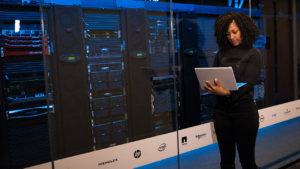Data and system security have become top priorities in the face of digital advancements and increasing cyber threats. A breach in data security can result in severe consequences, such as loss of customer trust, damage to brand reputation, regulatory fines, and even legal actions.
Furthermore, ensuring the integrity of systems is crucial for maintaining business operations continuity, avoiding disruptions that could lead to financial losses and negative impacts on customer relations.
In this article, we will discuss the differences and benefits of two commonly used security tests to identify and address flaws in systems. These are: Pentesting, a proactive technique that simulates real attacks on an organization’s systems. And Vulnerability Analysis, which focuses on identifying security flaws in systems, networks, or applications.
Pentest is a proactive technique that simulates a real cyber attack on an organization’s systems. However, during a Pentest, cybersecurity experts attempt to exploit vulnerabilities in systems, networks, or applications using techniques similar to those employed by malicious hackers. Thus, the goal is to identify weaknesses in security and provide recommendations to mitigate these vulnerabilities.
Benefits of Pentest:
1 Precise Identification of Vulnerabilities: Pentest reveals specific vulnerabilities that may go unnoticed in a conventional security analysis, allowing the company to take corrective actions before they are exploited by attackers. For example, it uncovers inadequate security configurations that may lead to the leakage of sensitive information such as passwords, API keys, or user data. Another example is the discovery that a poorly configured application may allow a regular user to access protected administrative areas.
2 Simulation of real attacks: Simulating real attacks allows the organization to assess the effectiveness of its existing cybersecurity defenses. Thus, it’s possible to attempt to bypass firewalls, intrusion detection systems, email filters, and other security measures to determine if they can detect and block attacks in real-time. This assessment helps identify which defenses are robust and which may need improvements. Moreover, Pentest helps the organization prepare for a wide range of attack scenarios such as phishing, ransomware, SQL injection, and brute-force attacks. This enables the cybersecurity team to develop specific incident response plans and know how to act swiftly to contain an attack.
3 – Improvement of security posture: Based on the results of the Pentest, the company can strengthen its cybersecurity defenses by implementing proactive measures to mitigate risks, protect its digital assets, and comply with data protection standards and laws such as LGPD (Lei Geral de Proteção de Dados – General Data Protection Law).
Vulnerability Analysis: Identifying Security Flaws
Vulnerability Analysis is a systematic process of identifying and classifying vulnerabilities in systems, networks, or applications. However, unlike Pentest, which simulates a real attack, Vulnerability Analysis focuses on identifying security flaws and assessing their potential impact. This process may involve using automated tools to scan systems for known vulnerabilities.
Benefits of Vulnerability Analysis:
1 – Early Identification of Vulnerabilities: One of the greatest advantages of vulnerability analysis is the ability to identify security flaws before they are exploited by hackers. Therefore, by conducting regular analyses, companies can discover vulnerabilities in their systems and applications and take preventive measures to correct them before they become targets of malicious attacks. This helps mitigate the risks of security breaches and protects the company’s confidential data and that of its customers.
2 – Comprehensive System Scanning: Vulnerability analysis employs automated tools that can scan systems quickly and comprehensively. These tools examine a wide variety of digital assets, including servers, databases, web applications, network devices, and endpoints. Comprehensive scanning allows the identification of vulnerabilities in all layers of the company’s IT infrastructure, providing a complete picture of the cybersecurity landscape.
3 – Compliance with Security Standards: In many sectors, vulnerability analysis is a mandatory requirement to ensure compliance with cybersecurity standards and regulations. For example, the PCI DSS (Payment Card Industry Data Security Standard) requires companies to conduct regular vulnerability scans on their systems to protect payment card data. Similarly, the LGPD (General Data Protection Law) establishes requirements to ensure the security of personal data of European citizens. Therefore, by conducting vulnerability analysis, companies can demonstrate compliance with these standards and avoid potential fines and penalties for non-compliance.
Choosing the Right Approach for Your Company:
In summary, both Pentesting and vulnerability analysis play essential roles in protecting an organization’s digital assets. While Pentesting simulates real attacks to identify specific vulnerabilities, vulnerability analysis focuses on early identification of system-wide security flaws. However, by understanding the differences between these approaches, companies can choose the most suitable strategy to strengthen their cybersecurity defenses and protect their data against digital threats.
At STWBRASIL, we offer customized cybersecurity solutions, including Pentesting and vulnerability analysis, to help your company tackle the challenges of the digital age. Contact us today and discover how we can protect your digital assets against cyber threats.





